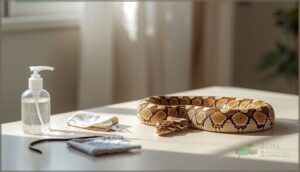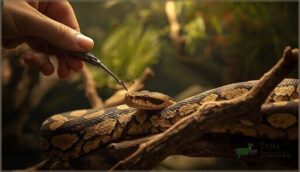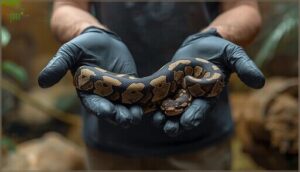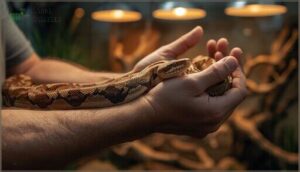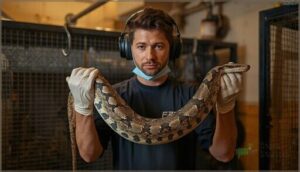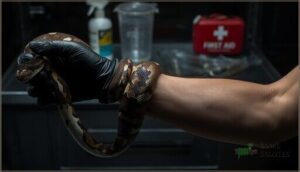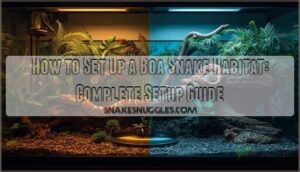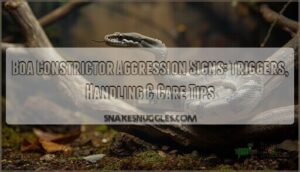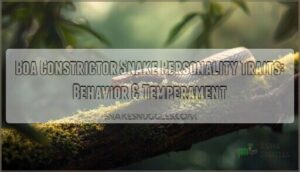This site is supported by our readers. We may earn a commission, at no cost to you, if you purchase through links.

A boa constrictor’s muscular body wraps around your arm with surprising force—not aggressive, just testing its new perch. This moment determines everything: panic, and you risk injury to both yourself and your snake. Stay calm, support the weight properly, and you’ve just built trust that makes every future interaction safer.
Most bite incidents and handling injuries stem from predictable mistakes: approaching too quickly, gripping instead of supporting, or misreading the snake’s body language. Mastering boa snake handling techniques isn’t about dominance—it’s about reading cues, moving with intention, and creating a routine where your snake feels secure enough to remain relaxed. The difference between a defensive strike and a calm exploration often comes down to how you position your hands in those first few seconds.
Table Of Contents
Key Takeaways
- Proper boa handling relies on reading body language cues like hissing, coiling, and tongue flicking to prevent defensive strikes, with most bite incidents stemming from predictable mistakes like approaching too quickly or misreading stress signals.
- Supporting at least 75% of a boa’s body weight with both hands during handling prevents spinal injury and escape attempts, while boas over 6 feet require multiple handlers to safely manage constriction risks.
- Waiting 48 hours post-feeding and avoiding handling during shedding periods reduces regurgitation risks and stress-related aggression by up to 50%, making timing as critical as technique.
- Daily 10-15 minute handling sessions build trust through predictability rather than dominance, with up to 90% of boas carrying Salmonella making post-handling hygiene protocols non-negotiable for handler safety.
Why Proper Boa Snake Handling Matters
Handling a boa snake the right way isn’t just about avoiding bites—it’s about building a relationship that benefits both you and your snake. When you handle your boa properly, you reduce stress, prevent injuries, and create a calmer, more confident animal.
Proper boa handling builds trust, reduces stress, and creates a calmer, healthier snake while preventing injuries for both of you
Let’s look at why mastering these techniques matters for every boa owner.
Benefits of Safe Handling for Boas
Safe handling techniques transform boa constrictor care into a foundation for long-term reptile welfare. You’ll see measurable improvements across five key areas:
- Reduced injury risk – Scale damage drops by 70% with proper body support
- Enhanced physical health – Muscle tone improves up to 25% through regular enrichment
- Decreased stereotypic behaviors – Consistent handling routines cut repetitive stress behaviors by 50%
- Easier veterinary care – 80% of well-handled boas remain calm during checkups
- Lower handler risk – Following safe handling techniques prevents bite escalation in 80% of interactions
These snake handling benefits create healthier, calmer constrictors. By following proper snake handling guidelines, boa owners can minimize risks and guarantee a safe environment for both the snake and the handler.
Building Trust and Reducing Stress
Trust building starts with reading your boa’s behavior. Handle gently for 10-15 minutes daily once acclimated, and you’ll see stress reduction take hold. Calm environments and patient handling techniques normalize cortisol levels while lowering defensive reactions by up to 50%. Your steady confidence matters—boas sense nervous movements. Skip handling during sheds or 48 hours post-feeding to maintain that trust.
Effective snake handling also relies on choice based methods to guarantee a safe and respectful experience.
Risks of Improper Handling
Mishandling your boa invites real trouble. Bites from larger specimens can require stitches, while improper restraint risks constriction around limbs or worse—your neck.
Up to 90% of boas harbor Salmonella, making hygiene lapses dangerous. Chronic stress from poor handling techniques weakens their immune systems, triggering aggression and even fatal diseases like body inclusion disease.
Emergency response skills aren’t optional when snake safety breaks down.
Preparing to Handle Your Boa Snake
Before you reach for your boa, you need to set yourself up for success. The right prep work keeps both you and your snake calm, safe, and in control.
Let’s cover the environment, the tools you’ll need, and how to read the signs that say “not today.
Choosing The Right Environment
Your boa’s enclosure design sets the stage for stress-free snake handling. Before you reach in, check that temperature gradients between 75–95°F and humidity control at 60–70% are stable—improper conditions make boas defensive.
Use substrate options like cypress mulch that won’t stick to scales. Proper lighting systems and boa enclosure setup help your snake feel secure, making reptile handling safer for both of you during boa constrictor care routines.
Tools and Supplies Needed
Professional snake hooks and feeding tongs keep distance between you and your boa constrictor during snake handling sessions. Protective gloves reduce bite risk for handlers, while disinfection supplies prevent cross-contamination between handling equipment and enclosures.
You’ll need 38-inch hooks for boas over six feet, stainless steel tongs for feeding, and EPA-registered disinfectants. These reptile handling tools make snake safety non-negotiable when applying proper handling techniques.
Recognizing When Not to Handle
Timing determines whether snake handling succeeds or fails. Skip handling during the shedding period—your boa becomes irritable and risks skin injury. After feeding, wait 48 hours to prevent regurgitation and esophageal damage.
Watch for stress signals like freezing, tight coiling, or absent tongue flicking. Health issues, visible injury response, or defensive behaviors mean hands off until conditions improve.
Step-by-Step Boa Snake Handling Techniques
Handling a boa snake isn’t something you want to wing. The right technique protects both you and your snake from unnecessary stress or injury.
Here’s how to approach, lift, and hold your boa with confidence every time.
Approaching Your Boa Safely
Think of your first move as setting the tone for everything that follows. Start by tapping gently near your boa with a snake hook—this signals your presence without startling it. Approach from the side, never from above, keeping your movements slow and deliberate.
This calm environment and gentle handling method reduces stress and builds trust, making safe handling techniques second nature for both you and your snake.
Supporting The Snake’s Body
Imagine holding your boa like a fragile branch—you need contact along its length, not just at two points. Use both hands to cradle the midsection and rear third, supporting at least 75% of its body. This proper body support prevents escape attempts and spinal injury while maintaining your snake’s comfort.
For adults over six feet, you’ll want a second handler to guarantee safe boa constrictor care and handling.
Recommended Handling Duration
Your handling sessions should last 10–15 minutes once your boa is comfortable with you. New snakes need just 5 minutes every few days—think of it as building tolerance gradually.
Handling time limits matter because boas can’t regulate temperature outside their enclosure. For stress reduction and proper boa constrictor care and handling, stick to once daily maximum.
Handling frequency directly impacts snake temperament and boa socialization success.
Handling Large Vs. Small Boas
Boa size comparison shapes every move you make. Small boas under 4 feet allow single-person handling with simple hand support, while large boa care demands two experienced handlers for snakes over 8 feet due to snake strength and constriction risks.
Your technique must adapt—spread your arms along the body for weight distribution with large boas, anticipate agile movements with small ones, and always prioritize reptile handling and safety through proper body support.
Recognizing Stress and Warning Signals
Your boa won’t always tell you outright when it’s uncomfortable, but it will show you. Learning to read your snake’s body language keeps both of you safe and builds the trust you need for successful handling.
Here’s what to watch for when your boa’s had enough or feels threatened.
Body Language and Defensive Behaviors
Reading your boa’s body language is essential for Snake Handling safety. Defensive Posturing—inflated bodies, rigid necks, and widened profiles—signals that your Boa Constrictor is uncomfortable.
Watch for Stress Signals like sustained hissing, open-mouthed gaping, or Body Tension with dorsal arching. Color Changes, such as temporary darkening, and Musking Behavior indicate escalating distress.
Recognizing these Reptile Behavior and Animal Behavior cues helps you respond appropriately before your snake strikes.
Signs Your Boa Needs a Break
Your snake’s comfort zone has clear boundaries. Stress signals demand attention when your boa constrictor shows escape-driven movement, persistent forward searching, or head retraction. These boa behavior cues tell you it’s time to respect handling limits.
Watch for these break timing indicators:
- Refusal to eat following your session, linked to 46% of stressed captive subjects
- Elevated breathing lasting over 15 minutes post-handling
- Extended hiding behavior increasing by 41% after frequent contact
Snake wellness depends on recognizing when your boa needs space.
How to Respond to Aggression
When defensive posture escalates—rigid body, rapid tongue flicking, or tensed coils—your bite response must be immediate but controlled. Stop handling. Don’t jerk away if struck; retreat toward your boa constrictor instead to prevent tooth damage.
For constriction release on limbs, use two handlers and unwind from the tail forward. Emergency protocols demand calm: panic tightens the grip.
Understanding snake behavior and animal psychology turns aggression triggers into teachable moments for safer snake handling.
Safety Precautions for Handlers
Handling a boa safely isn’t just about technique—it’s about knowing your limits and preparing for the unexpected. Large boas demand respect, extra precautions, and sometimes an extra pair of hands to keep everyone safe.
Let’s walk through the key safety measures that separate confident handlers from risky ones.
Handling Large Boas With Assistance
If your boa constrictor exceeds 6 feet, you’ll need at least two adults present for safe handling techniques. Team handling isn’t optional—it’s essential constriction safety. Each assistant’s role includes supporting separate body sections and maintaining clear communication throughout the session.
For boas over 10 feet, three trained handlers guarantee proper snake restraint and immediate emergency response if needed during boa handling.
Reducing The Risk of Bites or Constriction
Most bites happen when you overlook basic risk assessment and snake behavior cues. By mastering these constriction prevention strategies and safe handling practices, you’ll protect both yourself and your boa:
- Approach from the side during handling sessions, never from above, minimizing perceived threats and defensive strikes.
- Avoid feeding day handling entirely—hunger-driven mistakes account for the majority of bites.
- Support the entire body with both hands, distributing weight to prevent stress-related constriction.
- Watch for hissing or body inflation as your emergency response trigger to immediately cease interaction.
Hygiene and Preventing Zoonotic Illness
Pathogens like Salmonella lurk in up to 81% of captive snakes, turning every handling session into potential exposure.
You’ll slash infection risk by over 90% through disciplined handwashing after snake handling and weekly enclosure disinfection with 3% bleach.
Never clean reptile equipment in kitchen sinks—dedicated tools and outdoor cleaning zones are non-negotiable for pathogen control and household reptile safety.
Emergency Procedures and Handling Incidents
Even with careful handling, incidents can happen—and knowing how to respond quickly can prevent injury to both you and your boa. Whether you’re dealing with a defensive bite or an unexpected constriction, staying calm and using the right techniques makes all the difference.
Here’s what you need to know to handle emergencies safely and confidently.
What to Do if Bitten
Even calm boas can deliver a bite if startled. Your emergency response starts with staying composed—panicking only escalates the situation. Move toward the snake rather than jerking away to minimize tissue damage from rear-facing teeth.
Once released, wash the bite wound thoroughly with soap and water for infection prevention. Apply topical antibiotic and monitor for increased redness or swelling. If bleeding is heavy or punctures are deep, seek medical attention promptly to guarantee proper snakebite first aid.
Safely Releasing a Constricting Boa
If a boa constricts around your arm or body, stay calm—panic tightens the coils. Start manual uncoiling at the tail, the weakest anchor point for safe constriction release. Use gentle, steady pressure with smooth snake handling tools like a hook.
For large boas, two handlers guarantee reptile safety. Cold water can relax muscles in emergencies. These boa safety techniques and emergency response methods protect both handler and boa constrictor.
When to Seek Medical Attention
Most puncture wounds heal on their own, but medical interventions are necessary if redness spreads, fever develops, or swelling worsens after 24 hours—signs of infections requiring antibiotics. Bite complications like tissue necrosis or allergic reactions demand an emergency response. Eye or face injuries need immediate veterinary medicine expertise.
Proper boa constrictor care and animal welfare mean knowing when a professional reptile health assessment protects both handler and snake.
Frequently Asked Questions (FAQs)
Can I handle my boa after feeding?
No, you shouldn’t handle your boa after feeding. Wait at least 48 hours to reduce regurgitation risks and allow proper digestion.
Handling during this critical window disrupts metabolism and can trigger dangerous stress responses.
How often should I handle my boa?
Like tuning a harpsichord, finding the right handling frequency for your boa constrictor requires balance.
Handle your boa 1–2 times weekly for 10–15 minutes. This promotes snake habituation and reptile welfare without triggering boa stress.
Do boas recognize their owners over time?
Yes, boas recognize their owners through scent familiarity. They rely on their Jacobson’s organ to detect your unique smell, showing calmer behavior and reduced stress during handling sessions with familiar caretakers.
What temperature is safe for handling sessions?
Aim for ambient room temperatures between 75°F and 85°F during handling sessions.
Your boa’s ectothermic physiology relies on thermal gradient stability, so avoid exposing them to extremes below 70°F or above 95°F.
Can children safely handle boa constrictors?
Think of a boa as a living rope that tightens on instinct. Children under 12 need direct adult supervision for safe handling.
Age restrictions, child supervision, and understanding snake behavior through proper reptile handling techniques prevent handling risks with boa constrictors.
Conclusion
You might worry that constant vigilance takes the joy out of keeping boas—it doesn’t. Mastering boa snake handling techniques actually deepens the connection, turning tense encounters into fluid exchanges where both you and your snake move with confidence.
Every session where you read body language correctly, support weight evenly, and recognize when to step back reinforces a pattern: predictability replaces anxiety. That’s not just safer handling—it’s the foundation of a relationship built on mutual respect, not fear.
- https://reptifiles.com/boa-constrictor-care/boa-constrictor-handling/
- https://www.thebiodude.com/blogs/snake-caresheets/boa-constrictor-care-guide-and-bioactive-terrarium-maintenance
- https://www.knobcreeknaturalist.com/blog/handling-your-boa-constrictor
- https://www.scribd.com/document/514523620/captive-constrictor-snake-incidents-factsheet
- https://www.zoocheck.com/wp-content/uploads/2024/01/Snake-Handling-Excerpts-various.pdf

